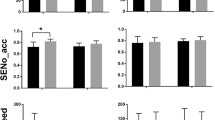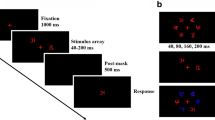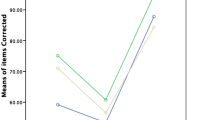Abstract
Within the framework of the theory of visual attention (TVA), the visual attention span (VAS) deficit among individuals with developmental dyslexia has been ascribed to the problems entailed by bottom–up (BotU) and top–down (TopD) attentional processes. The former involves two VAS subcomponents: the visual short-term memory storage and perceptual processing speed; the latter consists of the spatial bias of attentional weight and the inhibitory control. Then, what about the influences of the BotU and TopD components on reading? Are there differences in the roles of the two types of attentional processes in reading? This study addresses these issues by using two types of training tasks separately, corresponding to the BotU and TopD attentional components. Three groups of Chinese children with dyslexia—15 children each in the BotU training, TopD training, and non-trained active control groups were recruited here. Participants completed reading measures and a CombiTVA task which was used to estimate VAS subcomponents, before and after the training procedure. Results showed that BotU training improved both the within-category and between-category VAS subcomponents and sentence reading performance; meanwhile, TopD training enhanced character reading fluency through improving spatial attention capacity. Moreover, benefits on attentional capacities and reading skills in the two training groups were generally maintained three months after the intervention. The present findings revealed diverse patterns in the influences of VAS on reading within the TVA framework, which contributes to enriching the understanding of VAS-reading relation.



Similar content being viewed by others
Data Availability
All data is available when contacting the corresponding authors.
References
Arrington, C. N., Kulesz, P. A., Francis, D. J., Fletcher, J. M., & Barnes, M. A. (2014). The contribution of attentional control and working memory to reading comprehension and decoding. Scientific Studies of Reading, 18(5), 325–346. https://doi.org/10.1080/10888438.2014.902461
Bogon, J., Finke, K., Schulte-Korne, G., Muller, H. J., Schneider, W. X., & Stenneken, P. (2014). Parameter-based assessment of disturbed and intact components of visual attention in children with developmental dyslexia. Developmental Science, 17(5), 697–713. https://doi.org/10.1111/desc.12150
Bosse, M. L., Tainturier, M. J., & Valdois, S. (2007). Developmental dyslexia: The visual attention span deficit hypothesis. Cognition, 104(2), 198–230. https://doi.org/10.1016/j.cognition.2006.05.009
Bundesen, C. (1990). A theory of visual attention. Psychological Review, 97(4), 523–547. https://doi.org/10.1037/0033-295X.97.4.523
Chang, C. C., Liang, C., Chou, P. N., & Lin, G. Y. (2017). Is game-based learning better in flow experience and various types of cognitive load than non-game-based learning? Perspective from multimedia and media richness. Computers in Human Behavior, 71, 218–227. https://doi.org/10.1016/j.chb.2017.01.031
Chen, N. T., Zheng, M., & Ho, C. S. (2019). Examining the visual attention span deficit hypothesis in Chinese developmental dyslexia. Reading & Writing, 32(3), 639–662. https://doi.org/10.1007/s11145-018-9882-1
Cohen, J. (1988). Statistical power analysis for the behavioral sciences (2nd ed.). Lawrence Earlbaum Associates.
Corbetta, M., & Shulman, G. L. (2002). Control of goal-directed and stimulus-driven attention in the brain. Nature Reviews Neuroscience, 3(3), 201–215. https://doi.org/10.1038/nrn755
Dale, G., Joessel, A., Bavelier, D., & Green, C. S. (2020). A new look at the cognitive neuroscience of video game play. Annals of the New York Academy of Sciences, 1464(1), 192–203. https://doi.org/10.1111/nyas.14295
Ekstrand, C., Neudorf, J., Gould, L., Mickleborough, M., & Borowsky, R. (2019). Where words and space collide: The overlapping neural activation of lexical and sublexical reading with voluntary and reflexive spatial attention. Brain Research, 1706, 1–12. https://doi.org/10.1016/j.brainres.2018.10.022
Fan, J., McCandliss, B. D., Sommer, T., Raz, A., & Posner, M. I. (2002). Testing the efficiency and independence of attentional networks. Journal of Cognitive Neuroscience, 14(3), 340–347. https://doi.org/10.1162/089892902317361886
Freedman, L., Zivan, M., Farah, R., & Horowitz-Kraus, T. (2020). Greater functional connectivity within the cingulo-opercular and ventral attention networks is related to better fluent reading: A resting-state functional connectivity study. NeuroImage: Clinical, 26, 102214. https://doi.org/10.1016/j.nicl.2020.102214
Green, C. S., & Bavelier, D. (2012). Learning, attentional control, and action video games. Current Biology, 22(6), R197–R206. https://doi.org/10.1016/j.cub.2012.02.012
Gustafson, S., Ferreira, J., & Rönnberg, J. (2007). Phonological or orthographic training for children with phonological or orthographic decoding deficits. Dyslexia, 13, 211–229. https://doi.org/10.1002/dys.339
Habekost, T. (2015). Clinical TVA-based studies: A general review. Frontiers in Psychology, 6, 1–18. https://doi.org/10.3389/fpsyg.2015.00290
Jewell, G., & McCourt, M. E. (2000). Pseudoneglect: A review and meta-analysis of performance factors in line bisection tasks. Neuropsychologia, 38, 93–110. https://doi.org/10.1016/S0028-3932(99)00045-7
Kollins, S. H., DeLoss, D. J., Cañadas, E., Lutz, J., Findling, R. L., Keefe, R. S. E., Epstein, J. N., Cutler, A. J., & Faraone, S. V. (2020). A novel digital intervention for actively reducing severity of paediatric ADHD (STARS-ADHD): A randomized controlled trial. The Lancet Digital Health, 2(4), e168–e178. https://doi.org/10.1016/S2589-7500(20)30017-0
Kyllingsbaek, S. (2006). Modeling visual attention. Behavior Research Methods, 38(1), 123–133. https://doi.org/10.3758/BF03192757
Langer, N., Benjamin, C., Minas, J., & Gaab, N. (2015). The neural correlates of reading fluency deficits in children. Cerebral Cortex, 25(6), 1441–1453. https://doi.org/10.1093/cercor/bht330
Li, J., Yang, Y., & Zhao, J. (2021). Reduced processing speed and abnormal attentional weight at the cores of visual simultaneous processing deficit in Chinese children with developmental dyslexia (in Chinese). Acta Psychologica Sinica, 53(7), 1–16. https://doi.org/10.3724/SP.J.1041.2021.001
Liebel, S. W., Jones, E. C., Oshri, A., Hallowell, E. S., Jerskey, B. A., Gunstad, J., & Sweet, L. H. (2017). Cognitive processing speed mediates the effects of cardiovascular disease on executive functioning. Neuropsychology, 31(1), 44–51. https://doi.org/10.1037/neu0000324
Liu, S., & Liu, D. (2020). Visual-spatial attention and reading achievement in Hong Kong Chinese children: Evidence from a one-year longitudinal study. Scientific Studies of Reading, 24(3), 214–228. https://doi.org/10.1080/10888438.2019.1648475
Liu, S., Liu, D., Pan, Z., & Xu, Z. (2018). The association between reading abilities and visual-spatial attention in Hong Kong Chinese children. Dyslexia (Chichester, England), 24(3), 263–275. https://doi.org/10.1002/dys.1584
Lyon, G. R., Shaywitz, S. E., & Shaywitz, B. A. (2003). A definition of dyslexia. Annals of Dyslexia, 53(1), 1–14. https://doi.org/10.1007/s11881-003-0001-9
Mahdieh, L., Zolaktaf, V., & Karimi, M. T. (2020). Effects of dynamic neuromuscular stabilization (DNS) training on functional movements. Human Movement Science, 70, 102568. https://doi.org/10.1016/j.humov.2019.102568
Martin, A., Schurz, M., Kronbichler, M., & Richlan, F. (2015). Reading in the brain of children and adults: A meta-analysis of 40 functional magnetic resonance imaging studies. Human Brain Mapping, 36(5), 1963–1981. https://doi.org/10.1002/hbm.22749
Niolaki, G. Z., & Masterson, J. (2013). Intervention for a multi-character processing deficit in a Greek-speaking child with surface dyslexia. Cognitive Neuropsychology, 30(4), 208–232. https://doi.org/10.1080/02643294.2013.842892
Schneider, W. J., & McGrew, K. S. (2012). The Cattell-Horn-Carroll model of intelligence. In D. P. Flanagan & P. L. Harrison (Eds.), Contemporary intellectual assessment: Theories, tests, and issues (pp. 99–144). The Guilford Press.
Snowling, M. J., & Melby-Lervåg, M. (2016). Oral language deficits in familial dyslexia: A meta-analysis and review. Psychological Bulletin, 142(5), 498–545. https://doi.org/10.1037/bul0000037
Stefanac, N., Spencer-Smith, M., Brosnan, M., Vangkilde, S., Castles, A., & Bellgrove, M. (2019). Visual processing speed as a marker of immaturity in lexical but not sublexical dyslexia. Cortex, 120, 567–581. https://doi.org/10.1016/j.cortex.2019.08.004
Taran, N., Farah, R., DiFrancesco, M., Altaye, M., Vannest, J., Holland, S., Rosch, K., Schlaggar, B. L., & Horowitz-Kraus, T. (2022). The role of visual attention in dyslexia: Behavioral and neurobiological evidence. Human Brain Mapping, 43(5), 1720–1737. https://doi.org/10.1002/hbm.25753
Thurmann-Moe, A. C., Melby-Lervåg, M., & Lervåg, A. (2021). The impact of articulatory consciousness training on reading and spelling literacy in students with severe dyslexia: An experimental single case study. Annals of Dyslexia, 71(3), 373–398. https://doi.org/10.1007/s11881-021-00225-1
Valdois, S., Peyrin, C., Lassus-Sangosse, D., Lallier, M., Demonet, J. F., & Kandel, S. (2014). Dyslexia in a French-Spanish bilingual girl: Behavioural and neural modulations following a visual attention span intervention. Cortex, 53, 120–145. https://doi.org/10.1016/j.cortex.2013.11.006
Van Den Boer, M., Van Bergen, E., & De Jong, P. F. (2014). Underlying skills of oral and silent reading. Journal of Experimental Child Psychology, 128, 138–151. https://doi.org/10.1016/j.jecp.2014.07.008
VandenBos, G. R. (Ed.). (2015). APA dictionary of psychology (2nd ed.). Washington, DC: American Psychiatric Association. https://doi.org/10.1037/14646-000
Wang, X. L., & Tao, B. P. (1996). Chinese character recognition test battery and assessment scale for primary school children (in Chinese). Shanghai Education Press.
Wen, X., Yao, L., Liu, Y., & Ding, M. (2012). Causal interactions in attention networks predict behavioral performance. Journal of Neuroscience, 32, 1284–1292. https://doi.org/10.1523/JNEUROSCI.2817-11.2012
Yan, X., Jiang, K., Li, H., Wang, Z., Perkins, K., & Cao, F. (2021). Convergent and divergent brain structural and functional abnormalities associated with developmental dyslexia. eLife, 10, e69523. https://doi.org/10.7554/eLife.69523
Zhao, J., Kwok, R. K. W., Liu, M. L., & Huang, C. (2017). Underlying skills of oral and silent reading fluency in Chinese: Perspective of visual rapid processing. Frontiers in Psychology, 7, 2082. https://doi.org/10.3389/fpsyg.2016.02082
Zhao, J., Liu, H. L., Li, J. X., Sun, H. X., Liu, Z. H., Gao, J., Liu, Y., & Huang, C. (2019). Improving sentence reading performance in Chinese children with developmental dyslexia by training based on visual attention span. Scientific Reports, 9(1), 18964. https://doi.org/10.1038/s41598-019-55624-7
Zhao, J., Li, J., & Yang, Y. (2021). Reduced perceptual processing speed and atypical attentional weight at the cores of visual simultaneous processing deficits in Chinese children with developmental dyslexia: A parameter-based assessment of visual attention. Current Psychology, 42(4), 1–14. https://doi.org/10.1007/s12144-021-01691-x
Zhao, J., Song, Z., Zhao, Y., Thiebaut de Schotten, M., Altarelli, I., & Ramus, F. (2022a). White matter connectivity in uncinate fasciculus accounts for visual attention span in developmental dyslexia. Neuropsychologia, 177, 108414. https://doi.org/10.1016/j.neuropsychologia.2022.108414
Zhao, J., Wang, J., Huang, C., & Liang, P. (2022b). Involvement of the dorsal and ventral attention networks in visual attention span. Human Brain Mapping, 43(6), 1941–1954. https://doi.org/10.1002/hbm.25765
Zhang, H. C., & Wang, X. P. (1985). Raven standard progressive matrices: Chinese city revision (in Chinese). Beijing Normal University Publishing House.
Zoubrinetzky, R., Collet, G., Nguyen-Morel, M. A., Valdois, S., & Serniclaes, W. (2019). Remediation of allophonic perception and visual attention span in developmental dyslexia: A joint assay. Frontiers in Psychology, 10, 1502. https://doi.org/10.3389/fpsyg.2019.01502
Acknowledgements
We are deeply grateful to the children, their parents, and teachers who participated in our measures. We would like to thank Editage (www.editage.cn) for English language editing.
Funding
This work was supported by the National Natural Science Foundation of China (grant number: 31871117).
Author information
Authors and Affiliations
Corresponding authors
Ethics declarations
Conflict of interest
The authors declare no competing interests.
Additional information
Publisher's note
Springer Nature remains neutral with regard to jurisdictional claims in published maps and institutional affiliations.
Supplementary Information
Below is the link to the electronic supplementary material.
Rights and permissions
Springer Nature or its licensor (e.g. a society or other partner) holds exclusive rights to this article under a publishing agreement with the author(s) or other rightsholder(s); author self-archiving of the accepted manuscript version of this article is solely governed by the terms of such publishing agreement and applicable law.
About this article
Cite this article
Ren, X., Li, J., Liu, J. et al. Intervention targeting different visual attention span components in Chinese children with developmental dyslexia: a study based on Bundesen’s theory of visual attention. Ann. of Dyslexia 73, 487–509 (2023). https://doi.org/10.1007/s11881-023-00288-2
Received:
Accepted:
Published:
Issue Date:
DOI: https://doi.org/10.1007/s11881-023-00288-2




